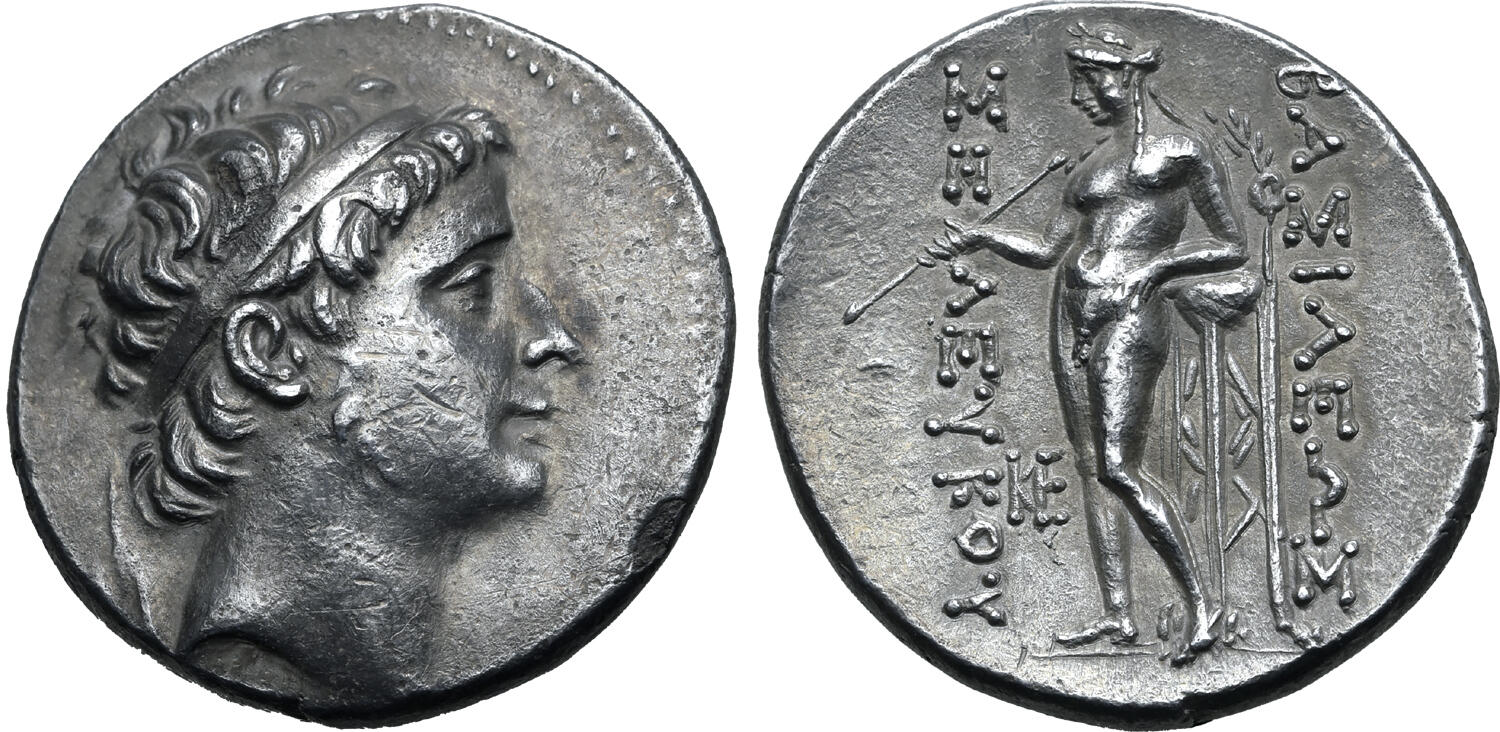Antioch (Seleucus II), silver, tetradrachms (Seleucus II/standing Apollo) (240-232 BCE)
From SILVER
(Redirected from Antioch (Seleucus II), silver, tetradrachms (246-226/5 BCE))
240 BCE - 232 BCE Silver 2,684 kg
Description
| ObverseInscription or printing placed on the obverse.: | Diademed head to right |
| ReverseInscription or printing placed on the reverse.: | BAΣIΛEΩΣ to right, ΣEΛEYKOY to left (Greek).Apollo standing to left, testing arrow and leaning on tall tripod, KE monogram to inner left |
Mint and issuing power
| MintIdentifies the place of manufacture or issue of a numismatic object.: | Antioch | Ancient regionAncient region.: | Syria | Modern countryModern country: Turkey | AuthorityIdentifies the issuing power. The authority can be "pretended" when the name or the portrait of X is on the coin but he/she was not the issuing power. It can also be "uncertain" when there is no mention of X on the coin but he/she was the issuing power according to the historical sources: | Seleucid Dynasty (312-63 BC), Seleucus II Callinicus (Seleucid king, 246-225 BC) |
Chronology
| FromIdentifies the initial date in a range assigned in a numismatic context. | 240 BCE | toIdentifies the final date in a range assigned in a numismatic context.. | 232 BCE | PeriodTime period of the numismatic object.: Hellenistic 323-30 BC |
Physical description
| MetalThe physical material (usually metal) from which an object is made.: | Silver |
Median weightMedian of the weights of numismatic objects (in grams). in grams | 16.90 | DenominationTerm indicating the value of a numismatic object. Examples: tetradrachm, chalkous, denarius.: | tetradrachm |
StandardStandard.: | Attic |
Image

S1796 Antioch Seleucus II tetradrachm.jpg [1]
References
| Die study referencePublication of the study: | Le Rider 19991Le Rider 1999, p. 62-66 | ||
| Coin series referenceReference to coin series study: | WSM2WSM, n° 996, SC I3SC I, n° 689.4, HGC 94HGC 9, n° 303p | ||
| Coin series web referenceCoin series web references: | |||
Obverse dies distribution
| FrequencyFrequency of specimen in distribution. ᵖ | Number of obversesNumber of obverse dies. ᵖ (o) | % (o) | Number of coinsNumber of coins. (n) | % (n) | Die nameName(s) of the die(s). |
| 4 | 1 | 12.5 | 4 | 3.64 | 4 |
| 9 | 1 | 12.5 | 9 | 8.18 | 3 |
| 12 | 1 | 12.5 | 12 | 10.91 | 1 |
| 15 | 1 | 12.5 | 15 | 13.64 | 7 |
| 16 | 1 | 12.5 | 16 | 14.55 | 5 |
| 17 | 1 | 12.5 | 17 | 15.45 | 2 |
| 18 | 1 | 12.5 | 18 | 16.36 | 8 |
| 19 | 1 | 12.5 | 19 | 17.27 | 6 |
| Total | 8 of 8 | 100 | 110 of 110 | 100 |
Reverse dies distribution
no distribution is available
Quantification
| Number of obversesNumber of obverse dies. ᵖ (o) | 8 | Number of singletons (o1)The number of singleton coins. ᵖ | |
| Number of reverse diesNumber of reverse dies. (r) | 68 | Number of coinsNumber of coins. (n) | 110 |
| Coins per obverse dieNumber of coins per obverse die. (n/o) | 13.75 | Coins per reverse dieNumber of coins per reverse die. (n/r) | 1.62 |
| Reverse per obverse ratioRatio of obverse dies divided by reverse dies. (r/o) | 8.5 | Percentage of singletons (o1)number of coins (n) divided by the number of singletons (o1) ᵖ | % |
| Original number of dies (O) (Carter 1983 formula)The estimation of the number of coins according to Carter 1983 ᵖ | 7.94 | Coins struck if 20,000 as average productivity per dieCoins made if the average productivity for obverses (according to Carter) is 20,000. ᵖ | 158,800 |
| Original number of dies (O) (Esty 2011 formula)The estimation of the number of coins according to the singleton formula in Esty 2011 ᵖ (O) | 8.63 | Survival rate if 20,000 as average productivity per dieSurvival rate if average productivity is 20,000. ᵖ | 0.00069 |
| Coverage (o = % of O) (Esty 1984 formula)Esty 1984 - coverage (% of O) ᵖ (o = % of O) | % | Die productivity if survival rate 1/2,000Average productivity if survival rate is 1/2,000. ᵖ | 27,707.81 |
| Weight of silver (in kg) if 20,000 coins per die (O = Carter formula)Carter 1983 * Median weight * 20000 (*10 if gold or electrum) ᵖ | 2,684 kg <br /> 2,684 kg | Die productivity if survival rate 1/5,000Average productivity if survival rate is 1/5,000. ᵖ | 69,269.52 |
Remarks
Most likely one single workstation Likely military
References
- ^ Le Rider, Georges (1999), Antioche de Syrie sous les séleucides : corpus des monnaies d'or et d'argent. I, De Séleucos I à Antiochos V, c. 300-161, Mémoires de l'Académie des inscriptions et belles-lettres, n.s. 19, Paris, 260 p., 27 pl.
- ^ Newell, Edward T. (1941), The coinage of the western Seleucid mints from Seleucus I to Antiochus III, Numismatic Studies 4, New York, 450 p., LXIV pl.
- ^ Houghton, Arthur - Lorber, Catharine (2002), Seleucid coins : a comprehensive catalogue. Part 1, Seleucus I through Antiochus III, New York - Lancaster - London, 2 v. (xxxviii, 488 p. + 300 p.), 101 pl.
- ^ Hoover, Oliver D. (2009), Handbook of ancient Syrian coins : royal and civic issues, fourth to first centuries BC, The Handbook of Greek Coinage 9, Lancaster, lxix, 332 p.